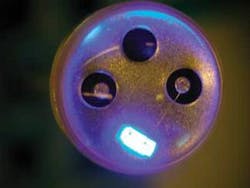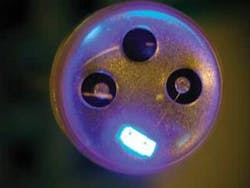Semipolar blue LEDs arise from high-quality GaN substrates
The inventor of the blue-light-emitting diode (LED), Shuji Nakamura, and his group at the University of California, Santa Barbara (Santa Barbara, CA), have announced significant progress in the fabrication of blue semipolar LEDs with higher efficiency and brightness over existing blue LEDs without an increase in power consumption-a promising development for solid-state-lighting applications. Centered at a wavelength of 443.9 nm, the semipolar LEDs operate at 3.20 V at a drive current of 20 mA under pulsed operation (at 10% duty cycle) with an output power of 16.21 mW. The external quantum efficiency of 29% is close to previous results for nonpolar and semipolar violet LEDs.
The indium gallium nitride/gallium nitride (InGaN/GaN) multiple-quantum-well LEDs were grown on low-defect-density (10-1-1) bulk GaN substrates using metal-organic chemical-vapor deposition, at an inclined angle of 45º with respect to the usual c direction. Along with the improvements of the crystal growth, the availability of high-quality GaN m-plane substrates from Mitsubishi Chemical was important to the breakthrough, say the researchers, accounting for reduced stacking-fault and threading-dislocation densities. They also note that results are bound to improve with any effort to enhance the processing of the devices at the epitaxial, chip, or package level. Contact Barry Zhong at [email protected].

